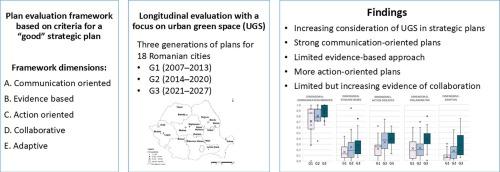Evaluating trends in the consideration of urban green spaces in strategic spatial planning: Insights from Romania
IF 9.2
1区 环境科学与生态学
Q1 ECOLOGY
引用次数: 0
Abstract
In Europe, strategic spatial planning is increasingly recognized as a public-sector-led approach that brings together multiple actors in collaborative settings to build long-term visions for urban development. Despite the growing importance of urban green spaces (UGS) in fostering sustainable and liveable cities, systematic longitudinal and comparative analyses of UGS integration into strategic urban plans remain scarce. Drawing on established normative criteria for “good” strategic plans and evidence from practice, we propose an evaluation framework to assess the communication-oriented, evidence-based, action-oriented, collaborative and adaptive dimensions of plans. We apply the framework to three generations of strategic plans from 18 Romanian cities. Our results indicate that, while UGS are frequently mentioned, their integration into actionable strategies is inconsistent. We observe, however, a positive trend in the incorporation of UGS into successive plan iterations. To the best of our knowledge, this study is the first to use a longitudinal research design to systematically assess changes in the quality of strategic urban plans, with a particular focus on UGS. We discuss our framework and findings in the context of broader debates about the nature of strategic planning and the mainstreaming of environmental aspects into strategic plans. Applying the framework in different countries and planning contexts could assess its transferability and reveal how institutional arrangements, planning traditions, and socio-political environments influence the quality of strategic plans over time.

评估战略空间规划中考虑城市绿色空间的趋势:来自罗马尼亚的见解
在欧洲,战略性空间规划越来越被认为是一种公共部门主导的方法,它将多方参与者聚集在一起,共同制定城市发展的长期愿景。尽管城市绿地(UGS)在促进城市可持续发展和宜居方面的重要性日益增加,但将城市绿地纳入战略性城市规划的系统纵向和比较分析仍然很少。根据“好”战略计划的既定规范标准和实践证据,我们提出了一个评估框架,以评估计划的沟通导向、循证导向、行动导向、协作和适应性维度。我们将该框架应用于罗马尼亚18个城市的三代战略规划。我们的研究结果表明,虽然UGS经常被提及,但它们在可操作战略中的整合并不一致。然而,我们观察到将UGS合并到连续的计划迭代中的积极趋势。据我们所知,这项研究是第一次使用纵向研究设计来系统地评估战略城市规划质量的变化,特别关注UGS。我们在关于战略规划的本质和将环境因素纳入战略规划主流的广泛辩论的背景下讨论我们的框架和研究结果。在不同国家和规划背景下应用该框架可以评估其可转移性,并揭示体制安排、规划传统和社会政治环境如何随着时间的推移影响战略计划的质量。
本文章由计算机程序翻译,如有差异,请以英文原文为准。
求助全文
约1分钟内获得全文
求助全文
来源期刊

Landscape and Urban Planning
环境科学-生态学
CiteScore
15.20
自引率
6.60%
发文量
232
审稿时长
6 months
期刊介绍:
Landscape and Urban Planning is an international journal that aims to enhance our understanding of landscapes and promote sustainable solutions for landscape change. The journal focuses on landscapes as complex social-ecological systems that encompass various spatial and temporal dimensions. These landscapes possess aesthetic, natural, and cultural qualities that are valued by individuals in different ways, leading to actions that alter the landscape. With increasing urbanization and the need for ecological and cultural sensitivity at various scales, a multidisciplinary approach is necessary to comprehend and align social and ecological values for landscape sustainability. The journal believes that combining landscape science with planning and design can yield positive outcomes for both people and nature.
 求助内容:
求助内容: 应助结果提醒方式:
应助结果提醒方式:


